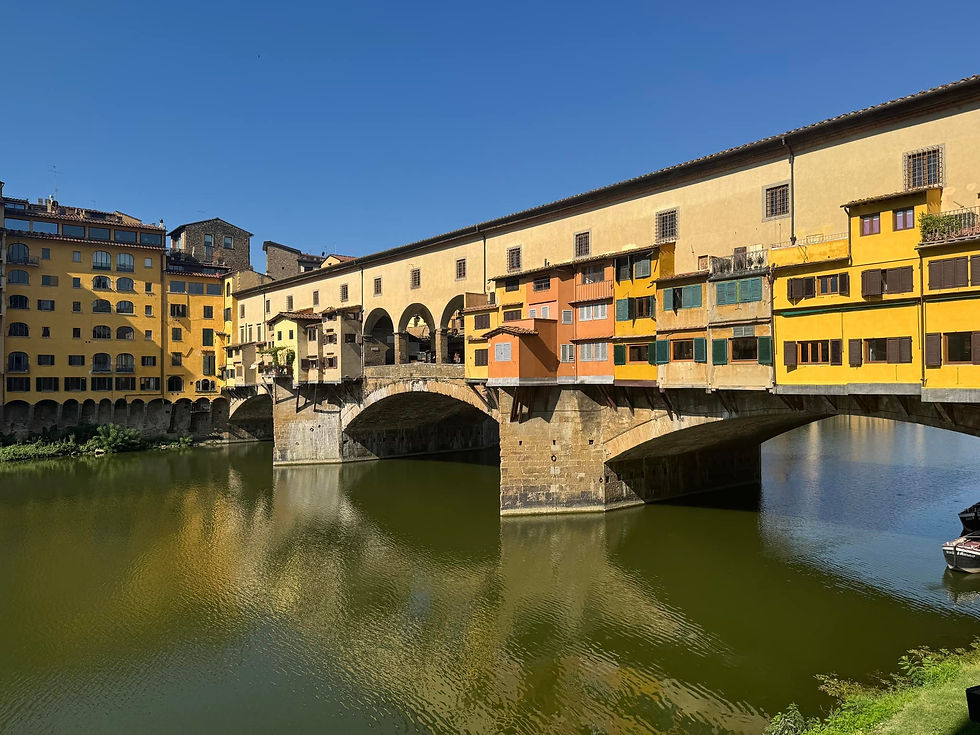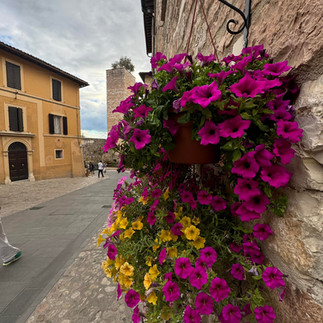5 Ways to Survive (and Thrive) in peak-season Tuscany
- Phil Thomas

- Aug 22
- 6 min read

Leafing through your Lonely Planet on guidance on how best to experience Tuscany in July, you’re likely to be confronted with some simple guidance – DON’T. All the locals leave for the coast, you can never find a parking space and you’ll resemble a baked risotto after wandering round Florence in 40C heat….blah, blah, blah
Whilst the title of this article sounds the epitome of middle-class humblebragging ‘Yah dahling, we just about survived Toscana this summer,’ it is true that visiting in high summer requires a higher degree of planning and, yes, without this you will be turning an unfortunate shade of Chianti when you can’t find a parking space in San Gimigiano at 2pm.
You’ll still doubtless want to visit the big hitters of the region – and rightly so – but here are five suggestions, based on several summers' experience, to survive peak season Tuscany and enjoy the weather, wine and history all the more.
I’m assuming you’re already well versed in bringing copious amounts of water, sunscreen and hats (you’ll inevitably leave one on a café terrace) but if not, do.
1. Start Early…or Late
Yes, you’re on holiday and no, you didn’t come all this way to get up at the same time as you do for work. Feel better now that's out of your system? Good, now let me explain.

At 9am, Florence in August is a delight – cool, blue skyed and delightfully strollable. You can get a seat at any café for breakfast before you’re first in line when the Uffizi opens. Come 2pm, the whole place becomes Dante’s seventh circle of hell. Given it’s pushing 40C outside, this is an excellent time to be taking a nap!
For smaller towns on the tourist trail where there’s limited parking (San Gimigiano, Pienza, Volterra), tour groups descend like vultures from about 10am-12pm and again from 2pm-4pm, which add to the already congested feel. You've more chance of discovering the lost city of Atlantis than finding a parking space at these times. If you can’t bear the thought of the early start, late afternoon is an altogether more bearable time to arrive and stroll through any of these towns. While you're there, stay for an evening meal - it's still busy but decidedly less so than midday.
The same rule applies for outdoor attractions like Bagni San Felipi (well worth it, pictured) – a delight at 9.30, a theme park by 11.

2. Be A Glutton For Punishment

Food tours and cooking classes proliferate in Tuscany but really come into their own in high season (particularly small group ones). Alongside the obvious – you’re in Tuscany so the food will inevitably be fabulous – adding this to your August itinerary holds a couple of clear advantages.
Firstly, food tours normally guarantee you a table at multiple (air conditioned) locales en route, which you’ll be only too glad of. The modus operandi of every food tour I’ve done is to take you to places normal tourists don’t find (such as the oldest gelateria in Florence, which somehow isn’t on the regular tourist radar) so these places are often oases of calm.
Even better are cooking classes at Agriturismo sites dotted all over Tuscany. By design, these are restricted to small groups (Paul and I hit the jackpot when our class near San Gimigiano ended up being private to just the two of us) and you’ll learn to cook dishes that make you dream of a Tuscan August through those long winter nights. You'll get to sample your creation at the end of the class, often on an idyllic roof terrace without the need to signal six times to catch a waiter's attention.
Plot spoiler – use onions or garlic in your ragu, not both.
3. Go Where Others Don’t
I’m never going to sniffily assert that because somewhere features in a guidebook ‘must do’ list, you should avoid it - let's face it you'll end up in Florence and Siena at some point and quite right too. However, you have precious few bad options in Tuscany and it pays to do a bit of research to find destinations beyond the obvious big hitters. Two cases in point:

Certaldo (pictured) is on the train line from Florence to Siena, is the home of Boccacio and the Decamoron (read the book, the Netflix series was beyond terrible) and has an utterly beguiling old town, connected by a funicular. It’s close enough to San Gimignano to have a killer view of the Medieval Manhattan towers and has the best cingiale al ragu in Tuscany (appropriately enough for a clifftop town, this is a hill I’ll die on).
In the evening, the old town comes alive with live music, pavement cafes and one of the finest passegiatas you will find anywhere in Tuscany. You can even try onion gelato (Paul and my opinions on this differed rather sharply) - they're famous for their onions round here.
Many tourists will pass through between Florence and Siena and never set foot from the train. Certaldo therefore gets far fewer tourists than it deserves but I can't think of anywhere better to spend a summer's evening.

Val D’Orcia is well known for its ‘THIS IS TUSCANY’ landscape of rolling golden field dotted with Cypress trees and impossibly romantic farmhouses yet most visitors rush past its gateway town, San Quirico d'Orcia (pictured), on the way to Pienza and Montepulciano.
Understandable yet a mistake. The walled city has a lovely main street, superb wine tasting of the local Brunello and restaurants to compete with any in Tuscany. The best two are delightfully unpretentious - Il Garibaldi, in a hotel attached to a petrol station and La Torre which resembles a working man's club from the outside. They also hold a summer concert series - Paesaggi Musicali Toscani - (Tuscan Musical Landscapes) that take place all over the town and the surrounding landscape. The sunsets are spectacular too.
It's also a fantastic base to drive out to get your Tuscan landscape money shots including the famous Elysian Fields scene from Gladiator, which is located on the road between San Quirico and Pienza. As previous, come early or late.
4. Embrace the Festivities
Despite the stereotype that every Tuscan exits stage left for the coast the minute August arrives, this month is categorically festival season in much of the region. Assorted medieval festivals (Volterra’s and Montepulciano’s are among the biggest) together with Siena’s iconic Palio, whose second annual running takes place on 16thAugust each year (weather dependent).

Unfortunately my number one rule 'Get Here Early or Late' doesn't offer the latter option here. We discovered to our cost in not being able to find a single parking space in Montepulciano on Festival Sunday by 11am (not the end of the world – we diverted to Arezzo and very lovely it was too). So go early or go without.
The palio (pictured) is an outlier in actually being a multi-day festival. In the two days leading up to the main event, prove (test runs) are held twice a day – generally at 9am and 7pm – in the Campo (main square) and are free to attend.
If you’re more interested in the spectacle than the race itself, just show up an hour or so before and you can claim a place on the rails where you can see the action first hand. Morning is better for shade. Pick a contrade (somehow Paul backed the winning one - Il Lupo) and then go explore their district – come at lunchtime or dinner and you’ll find their festivities in full swing. Some even let you join them with advanced booking.
5. Go East (Life is – Relatively - Peaceful There)

As a rule of thumb, the bigger Eastern cities Arezzo and Orvieto (technically over the border in Umbria) don’t see nearly as many visitors as the big three (Florence, Siena, Pisa) but are just as memorable.
Orvieto’s cathedral rivals Florence’s, plus it has some remarkable frescos in the interior – if you enjoy kinky skeletons you’re in for a treat in the San Brizio Chapel. Arezzo (pictured) – of Life is Beautiful – bears a passing resemblance to Siena with its sloping main square and contrade (district) flags hanging out of every window. Their chosen festivity is jousting, rather than racing, taking place at the start of September.
It was a moment of real disappointment in finding out the districts joust against a set target and not each other albeit still quite the spectacle but that shouldn't stop you exploring this gorgeous town.
While Tuscany in peak season is not without challenges, with a little planning you can have the cypress-tinged time of your life. Tweaking your sleep pattern and being a little more adventurous with your itinerary and it’s not hard to understand how this region has been drawing in romantics of all ages for the past six centuries.













Comments